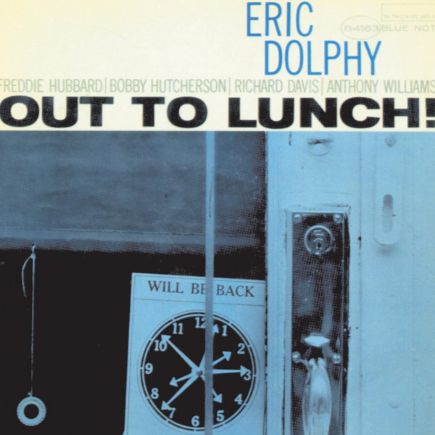Out to Lunch!: l’audace maîtrisée du jazz moderne
Enregistré le 25 février 1964 pour le label Blue Note, Out to Lunch! constitue l’ultime chef-d’œuvre d’Eric Dolphy, disparu tragiquement quelques mois plus tard. Véritable manifeste de liberté, l’album synthétise l’esprit d’expérimentation qui traverse le jazz de cette période charnière, alors que les codes traditionnels s’effacent au profit de formes d’expression plus ouvertes, plus abstraites, mais toujours ancrées dans une profonde connaissance de la tradition.
Avec cinq compositions originales, toutes signées Dolphy, l’album offre un panorama dense et audacieux de son univers musical. Chaque pièce révèle une facette singulière de son écriture : complexe mais accessible, exigeante sans jamais être hermétique. Aujourd’hui, Out to Lunch! est unanimement reconnu comme l’un des sommets du catalogue Blue Note, et plus largement comme une référence majeure du jazz d’avant-garde des années 1960.
En 1964, le jazz est en pleine mutation. Si le hard bop domine encore, des figures comme Ornette Coleman, Cecil Taylor ou John Coltrane bouleversent les formes établies, explorant de nouvelles libertés harmoniques et rythmiques. Dans ce contexte, Dolphy trace sa propre voie, refusant les dogmes tout en affirmant une vision résolument personnelle.
Loin du chaos, Out to Lunch! repose sur des structures inventives, des métriques atypiques (comme le 5/4 de Straight Up and Down ou la pulsation déstructurée de Hat and Beard), et une interaction collective d’une rare finesse. Dolphy y développe un langage anguleux, elliptique, parfois mordant, mais toujours traversé par un lyrisme profond.
Entouré d’un quintette d’exception – Freddie Hubbard (trompette), Bobby Hutcherson (vibraphone), Richard Davis (contrebasse) et Tony Williams (batterie, à peine âgé de 18 ans) –, Dolphy atteint ici une forme de plénitude artistique. La cohésion du groupe, l’intensité du dialogue, la richesse formelle et la liberté du propos font de cet enregistrement un jalon incontournable, à la fois énigmatique et lumineux.
Out to Lunch!: la audacia controlada del jazz moderno
Grabado el 25 de febrero de 1964 para el sello Blue Note, Out to Lunch! representa la última obra maestra de Eric Dolphy, quien fallecería trágicamente pocos meses después. Verdadero manifiesto de libertad, el álbum sintetiza el espíritu experimental que atravesaba el jazz en ese momento crucial, cuando los códigos tradicionales daban paso a formas de expresión más abiertas, más abstractas, pero siempre profundamente enraizadas en el conocimiento de la tradición.
Con cinco composiciones originales, todas firmadas por Dolphy, el álbum ofrece un panorama denso y audaz de su universo musical. Cada pieza revela una faceta singular de su escritura: compleja pero accesible, exigente sin llegar nunca al hermetismo. Hoy en día, Out to Lunch! es reconocido unánimemente como uno de los puntos culminantes del catálogo de Blue Note y, más ampliamente, como una referencia clave del jazz de vanguardia de los años sesenta.
En 1964, el jazz atraviesa una transformación profunda. Aunque el hard bop sigue dominando, figuras como Ornette Coleman, Cecil Taylor o John Coltrane redefinen las formas establecidas, explorando nuevas libertades armónicas y rítmicas. En este contexto, Dolphy traza su propio camino, rechazando los dogmas y afirmando una visión decididamente personal.
Lejos del caos, Out to Lunch! se apoya en estructuras inventivas, métricas inusuales (como el 5/4 de Straight Up and Down o la pulsación desarticulada de Hat and Beard), y una interacción colectiva de rara finura. Dolphy despliega un lenguaje anguloso, elíptico, a veces mordaz, pero siempre atravesado por un lirismo profundo.
Acompañado por un quinteto excepcional —Freddie Hubbard (trompeta), Bobby Hutcherson (vibráfono), Richard Davis (contrabajo) y Tony Williams (batería, con apenas 18 años)—, Dolphy alcanza aquí una forma de plenitud artística. La cohesión del grupo, la intensidad del diálogo, la riqueza formal y la libertad del discurso convierten esta grabación en un hito imprescindible, tan enigmático como luminoso.
Out to Lunch!: l’audacia controllata del jazz moderno
Registrato il 25 febbraio 1964 per l’etichetta Blue Note, Out to Lunch! rappresenta l’ultimo capolavoro di Eric Dolphy, scomparso tragicamente pochi mesi dopo. Vero e proprio manifesto di libertà, l’album sintetizza lo spirito di sperimentazione che attraversava il jazz in quella fase cruciale, in cui i codici tradizionali lasciavano spazio a forme espressive più aperte, più astratte, ma sempre profondamente radicate nella conoscenza della tradizione.
Con cinque composizioni originali, tutte firmate da Dolphy, l’album offre un panorama denso e audace del suo universo musicale. Ogni brano rivela una sfaccettatura unica della sua scrittura: complessa ma accessibile, esigente senza mai risultare ermetica. Oggi, Out to Lunch! è unanimemente riconosciuto come uno dei vertici del catalogo Blue Note e, più in generale, come una pietra miliare del jazz d’avanguardia degli anni Sessanta.
Nel 1964, il jazz è in piena trasformazione. Se il hard bop domina ancora, figure come Ornette Coleman, Cecil Taylor o John Coltrane mettono in discussione le forme consolidate, esplorando nuove libertà armoniche e ritmiche. In questo contesto, Dolphy traccia una strada autonoma, rifiutando ogni dogma e affermando una visione profondamente personale.
Lontano dal caos, Out to Lunch! si fonda su strutture inventive, metriche insolite (come il 5/4 di Straight Up and Down o la pulsazione disarticolata di Hat and Beard), e un’interazione collettiva di rara finezza. Dolphy sviluppa un linguaggio spigoloso, ellittico, a tratti pungente, ma sempre attraversato da un lirismo profondo.
Circondato da un quintetto d’eccezione —Freddie Hubbard (tromba), Bobby Hutcherson (vibrafono), Richard Davis (contrabbasso) e Tony Williams (batteria, appena diciottenne)—, Dolphy raggiunge qui una piena maturità artistica. La coesione del gruppo, l’intensità del dialogo, la ricchezza formale e la libertà dell’idea musicale fanno di questa registrazione una tappa imprescindibile, enigmatica e luminosa.
Out to Lunch!: the controlled boldness of modern jazz
Recorded on February 25, 1964, for the Blue Note label, Out to Lunch! stands as Eric Dolphy’s final masterpiece. He died tragically just a few months later, leaving this album as a true artistic testament. A manifesto of creative freedom, the record captures the experimental spirit of a pivotal era in jazz, when traditional codes were giving way to more open, abstract forms of expression—always grounded in a deep understanding of the tradition.
With five original compositions, all penned by Dolphy, the album presents a dense and daring overview of his musical world. Each piece reveals a distinct facet of his writing: complex yet accessible, demanding without ever being obscure. Today, Out to Lunch! is widely regarded as one of the high points of the Blue Note catalog, and more broadly, as a landmark of 1960s avant-garde jazz.
In 1964, jazz was undergoing profound change. While hard bop still held sway, figures like Ornette Coleman, Cecil Taylor, and John Coltrane were challenging established forms, exploring new harmonic and rhythmic freedoms. Within this evolving landscape, Dolphy forged his own path, rejecting dogma and asserting a singular artistic vision.
Far from chaotic, Out to Lunch! is built on inventive structures, unusual meters (such as the 5/4 of Straight Up and Down or the fractured pulse of Hat and Beard), and a collective interplay marked by rare precision. Dolphy develops a language that is angular, elliptical, at times biting, but always infused with deep lyricism.
Surrounded by an exceptional quintet—Freddie Hubbard (trumpet), Bobby Hutcherson (vibraphone), Richard Davis (bass), and Tony Williams (drums, just 18 at the time)—Dolphy reaches a moment of full artistic maturity. The group’s cohesion, the intensity of their dialogue, the formal richness and expressive freedom make this recording an essential milestone: enigmatic, radiant, and enduring.


